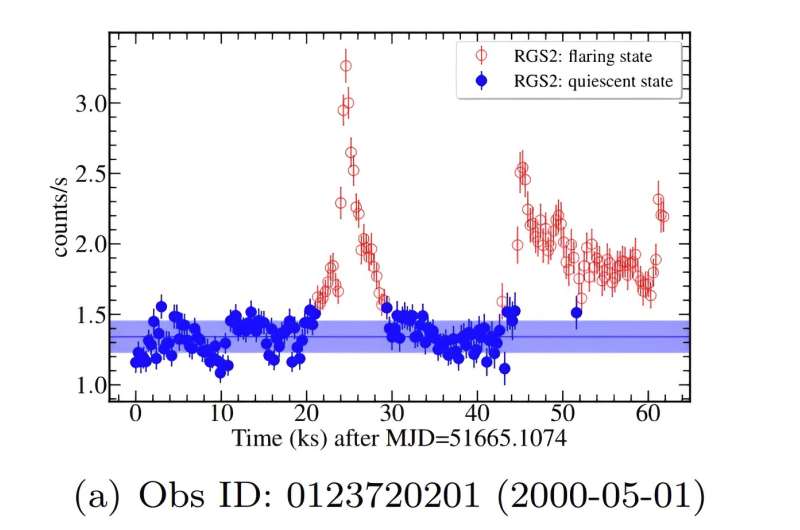March 7, 2024 report
This article has been reviewed according to Science X's editorial process and policies. Editors have highlighted the following attributes while ensuring the content's credibility:
fact-checked
preprint
trusted source
proofread
Observations inspect variability of a nearby ultra-fast rotating active star

Indian astronomers have conducted long-term X-ray observations of a nearby ultra-fast rotating active star known as AB Doradus A. Results of the observational campaign, published February 29 on the pre-print server arXiv, provide crucial insights into the short-term and long-term variability of this star.
Located some 48.4 light years away, AB Doradus A (or AB Dor A for short) is a K0-type star in the constellation Dorado that has recently reached the main sequence. It is similar in size to the sun, while its mass is approximately 0.86 solar masses. The star, which is part of a quintuplet stellar system, has a rotational period of about 0.51 days and showcases violent magnetic activity with average X-ray luminosity in the range of one nonillion erg/s.
AB Doradus A experiences frequent flaring episodes and exhibits periodic increases in activity. One of previous photometric studies of this star has revealed that it displays at least two different types of activity cycles: one with a period of 5–7 years in which activity switches between the two active longitudes, and another with a period of 19–22 years, similar to the 11-year solar cycle.
Therefore, in order to shed more light on the activity cycles of AB Doradus A and its variability in general, Gurpreet Singh and Jeewan C. Pandey of the Aryabhatta Research Institute of Observational Sciences (ARIES) in India, has analyzed the data mainly from ESA's XMM-Newton satellite, which monitors this star regularly.
"AB Dor was regularly observed by the RGS [reflection grating spectrometer onboard XMM-Newton] detector; therefore, we have used the RGS observations for further analysis. The XMM-Newton has observed AB Dor for 42 epochs from the year 2000 to 2022," the researchers wrote in the paper.
The study confirmed that AB Doradus A exhibits frequent flare events, accounting for an average of 57% of the total observation time. The analysis of the quiescent light curves unveiled the presence of rotational modulation in most observational epochs.
Based on the coronal imaging of AB Doradus A, the astronomers identified the presence of two distinct active longitudes, each situated 180 degrees apart. It appears that these active longitudes showcase migration and variations in their relative brightness, with one active longitude dominating the other.
By analyzing the long-term X-ray lightcurve of AB Doradus A, the researchers distinguished periods of approximately 3.6, 5.4, and 19.2 years. They assume that the 5.4-year period is linked to an X-ray flip-flop cycle, while the 19.2-year period may correspond to a long-term cycle. However, the authors of the paper added that the X-ray flip-flop cycle requires confirmation using long-term X-ray observations with adequate cadence.
More information: Gurpreet Singh et al, AB Dor: Coronal imaging and activity cycles, arXiv (2024). DOI: 10.48550/arxiv.2402.19083
Journal information: arXiv
© 2024 Science X Network




















